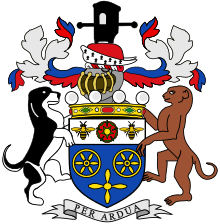William Black, Baron Black
William Rushton Black, Baron Black Kt (born January 12, 1893 in Barrow-in-Furness , Cumbria , † December 27, 1984 ) was a British engineer and entrepreneur in the automotive industry who was a member of the Life Peerage Act 1958 as a life peer in 1968 House of Lords was.
Life
Manager of the automotive industry
After attending the Barrow Secondary School, Black graduated from the Barrow Technical College and in 1908 became an employee of the Vickers mechanical engineering company , where he became plant director of the Vickers factory in Crayford in 1924 . In 1928 he moved to the Weymann bodywork factory as managing director , before becoming a board member and managing director of Park Royal Vehicles in 1934 , a Park Royal- based company that specialized in bus and rail vehicle bodies .
In 1939, Black became Chief Executive Officer (CEO) of Park Royay Vehicles and in this role led the merger with the Leeds- based coachbuilder Charles H. Roe Ltd to form Park Royal-Roe. He subsequently expanded the company, hiring key employees from rival companies Bristol Commercial Vehicles and Eastern Coach Works (ECW).
In 1949 Park Royal and Charles H. Roe Ltd were taken over by the commercial vehicle manufacturer Associated Commercial Vehicles (ACV), of which he became director. As such, he contributed greatly to the construction of the double-decker model modeling Routemaster at that from 1954 to 1968 from ACV subsidiaries Associated Equipment Company (AEC) for Transport for London was produced. In 1958 he finally became managing director of ACV. On July 15, 1958, he was beaten to the Knight Bachelor and from then on carried the suffix "Sir".
Chairman of the Board of Leyland Motors and Member of the House of Lords
After Henry Spurrier's death on June 17, 1964, Black succeeded him as Chairman of the Board of Leyland Motors and held this position until he was succeeded by Donald Stokes in 1968. He was also chairman of the National Research Development Corporation (NRDC), one of the British government founded body to transfer innovations from public research organizations to private companies.
By a letters patent dated June 21, 1968, Black was raised to the nobility due to the Life Peerages Act 1958 as a life peer with the title Baron Black , of Barrow-in-Furness in the County Palatine of Lancaster, and thus belonged to the nobility until his death the House of Lords as a member.
coat of arms
A curiosity that has also become known abroad came about because of his coat of arms : The authority responsible for this allowed him to depict his dog Fred and the monkey Bimbo. Fred, the lap dog of the newly ennobled, had run away regularly at home and walked to the nearby Chessington Zoo in Surrey, where his master's chauffeur would pick him up in the Rolls-Royce. In the same zoo of which Lord Black was co-director, Bimbo had broken out and was only recaptured after a well-publicized hunt. The Lord, grateful for the publicity, decided, "It would be a nice idea to include the couple in my coat of arms."
Web links
- William Black at Hansard (English)
- Entry in Leigh Rayment Peerage
Individual evidence
- ↑ London Gazette . No. 41450, HMSO, London, July 18, 1958, p. 4514 ( PDF , accessed October 16, 2013, English).
- ^ Life peerage for Sir William Black . In: Commercial Motor Archive of June 14, 1968
- ^ Entry in Der Spiegel from June 16, 1969
| personal data | |
|---|---|
| SURNAME | Black, William, Baron Black |
| ALTERNATIVE NAMES | Black, William Rushton, Baron Black |
| BRIEF DESCRIPTION | British engineer and entrepreneur |
| DATE OF BIRTH | January 12, 1893 |
| PLACE OF BIRTH | Barrow-in-Furness , Cumbria |
| DATE OF DEATH | December 27, 1984 |
